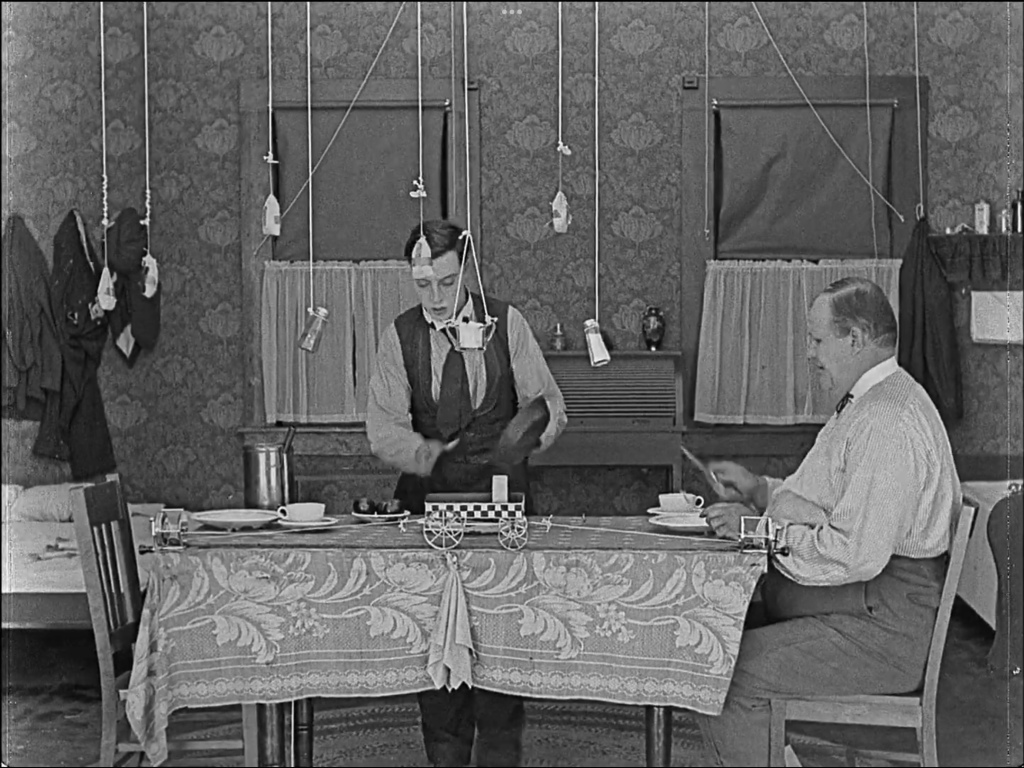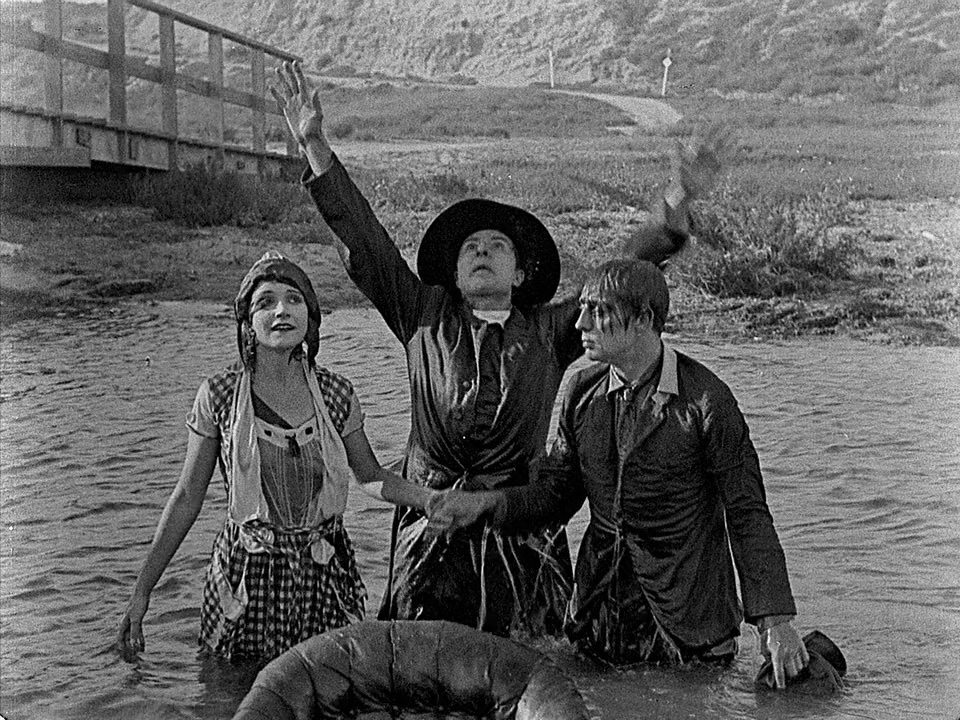Throughout The Scarecrow (1920), Buster Keaton employs elements of both realist and expressive styles of filmmaking, in order to create comedy in the most effective means possible.
Realist
- The costume design used throughout is an accurate representation of 1920s America.
- A multitude of commonly-found domestic appliances exist within the house, including: a record player, oven and a mirror.
- One of the intertitles remarks upon women getting the vote in 1919, a recently occurring significant historical event at the time of release.
- Coin operated gas meters were frequently found within apartment buildings, depicting a realist display of working class living standards.
- As Keaton sets the table, a static long shot with deep focus captures the scene, providing an unbiased, objective view of the room. The viewer is able to freely view the frame.
- The elaborate dual-function contraptions found within the house reference the illustrations of Rube Goldberg, which were popularised during the timeframe of release.
- Both of the main characters are farmers, representing the poverty-stricken society of the time period. The laborious manual labour the characters must endure is juxtaposed by the Rube Goldberg machinery.
- Both characters also wish to impress the same girl, demonstrating the patriarchal society of the time period, in addition to the duty held by many to settle down and start a family.
- The film is shot on location, depicting a realist rural setting.
- The chase sequence is filmed with a static long shot with deep focus, allowing the viewer to ‘cut with their eyes’.
- The wild dog that appears within the film were commonly found within the 1920s rural setting depicted throughout the film. In addition, Keaton’s character fears the possibility of the dog being rabid – rabies being a commonly occurring disease within dogs during this time.
- The titular scarecrow gag involves a commonly found decoy throughout American farmsteads with alcohol in its pocket. This is perhaps symbolic of the initiation of the Prohibition Era, which came into effect during the year of release (1920).
- During the kicking gag, the camera remains static. This allows the viewer to freely focus upon each of the three actors as they see fit.

Expressive
- The opening intertitle establishes the rural setting by illustratively describing the scene (“slowly and majestically the sun steals gradually over the hill-tops”) evoking a sense of romanticised pastoral imagery of the 1920s.
- The opening wide shot of the sunrise is shot with fast motion, Keaton’s use of hyperbolic mise-en-scène symbolically illustrates the dawn of a new day.
- A number of iris shots are utilised throughout the film, each directing the viewer’s attention towards a particular character or object.
- Keaton’s loose tooth is conveyed to the viewer by an exaggerated head bandage, additionally setting up the slapstick door gag. Keaton alternates between wide shots and reactionary closeups as to direct the viewer’s attention towards the punchline of a joke.
- The Rube Goldberg-inspired contraptions (including the fence prop) found within the house are extremely hyperbolic and unrealistic. These contraptions are used to create a sequence of surrealist gags, which are reminiscent of vaudeville theatre.
- During the meal between Keaton and Roberts, the pair’s movements are highly choreographed in order to heighten the effect of the abstract gag.
- The family of ducks bathing in the waste water is a highly unrealistic situation staged by Keaton in order to produce a comedic effect. This is also used to set up a later gag involving Keaton falling in the water in classic slapstick fashion.
- An introductory closeup of Sybil’s character immediately focuses the viewer’s attention towards her.
- The pace of editing quickens and fast motion is employed as the chase sequence ensues, manipulating the viewer’s emotions.
- Roberts miraculously manages to survive the impact of being run over, this unrealistic scenario successfully creates comedy. He is later seen on comically hyperbolic crutches and immediately knocked over again, further accentuating the gag.
- The scarecrow gag relies upon the viewer’s manipulated perspective in order to land. We are unable to see Keaton from the front, we therefore do not know he is the scarecrow. As the joke is repeated a second time, the viewer is in on the joke, creating a sense of comedic fulfilment.
- Keaton demonstrates his daring athleticism by impressively walking through the river on his hands, juxtaposing Roberts’ comical fall.
- The ‘accidental proposal’ is unrealistically successful, heightening the sheer absurdity of the scenario.
- The fake horse gag further increases the sense of idiosyncrasy Keaton possesses.
- The vicar just so happens to be conveniently standing on the side of the road, this unrealistic scenario further accentuates the expressive nonsensicality of the film.
- The final iris shot centralises the viewer’s attention onto Keaton placing the makeshift wedding ring on Sybil’s finger.
